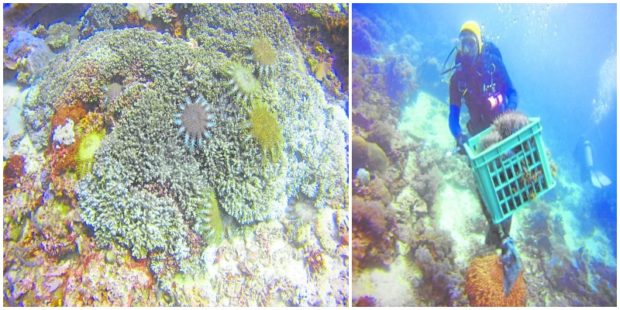
POISONOUS | A diver collects the poisonous crown-of-thorns starfish (left) in the waters near Tingloy, Batangas, during a cleanup operation in May 2022. (Photos from the DENR)
LUCENA CITY, Quezon City, Philippines — Thousands of crown-of-thorns starfish (COT) were removed from the seas off Batangas province by authorities who were responding to the outbreak of the poisonous starfish that could endanger local natural resources.
The Batangas Public Information Office (PIO), citing the report by Luis Awitan, chief of the Provincial Government Environment and Natural Resources Office, said authorities had collected 4,500 pieces of COT in Batangas City, 2,000 in Tingloy town, 968 in Calatagan, 202 in Nasugbu and 25 each in the municipalities of Taal and San Luis in their respective marine protected areas.
More than three tons of COT were also gathered in Mabini town, the report added.
The PIO said the local and provincial governments and marine conservation organizations had been conducting continuous cleanup operations and monitoring the presence of COT in Batangas seas.
“We consider this already an outbreak of COTs, or ‘taeng kalabaw’ (cow dung), a species of starfish that consumes coral reefs, [because] in one area, there are 15 to 30 COTs in a hectare of sea,” Awitan explained in the PIO report issued on Saturday.
The COT (Acanthaster planci) feeds on stony corals by sucking them dry of nutrients, leaving the reef dead and white.
Known as a “coral-killing sea star” because of its spines that cover its body, the COT matures into an adult in about two years, with the capacity to coordinate spawning in one region, and may deposit up to 60 million eggs in a season, effectively disturbing the marine environment.
It has venomous sharp spines that look like a crown. The COT is one of the largest kinds of starfish and can reach up to 20 inches in diameter.
Verde Island Passage
The COT outbreak in Batangas seas was discussed during the meeting of the Provincial Disaster Risk Reduction and Management Council on June 2.
Gov. Hermilando Mandanas, who presided over the meeting, said the provincial government had been focused on ending the COT outbreak to protect the local natural resources, particularly Verde Island Passage (VIP).
VIP traverses through the provinces of Batangas, Marinduque, Romblon, Occidental Mindoro, and Oriental Mindoro, which was recognized as the “center of global shorefish biodiversity” due to the high densities of marine resources in the area.
One of the Philippines’ richest fishing grounds, VIP teems with hundreds of species of fish, sea turtles, mangroves, seagrass, nudibranchs, and corals that some described as “extremely rare.”
The lives of over 2 million people from five provinces are inextricably connected to VIP, their main source of livelihood.
The COT is also dangerous to humans. Its prick causes stinging pain, bleeding, nausea, and swelling, which may last a week.
RELATED STORIES
Corals at risk as poisonous starfish spreads in S. Leyte waters
Crown-of-thorns starfish outbreak reported in sea off Southern Leyte
Ormoc agri office checking crown-of-thorn starfish in city’s waters